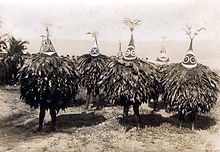Duk-duk

Duk-Duk is a secret society that is part of the traditional Tolai culture from the Rabaul area in New Britain ( Papua New Guinea ) in the South Pacific. The origin of this union lies in New Ireland , around 1830 Duk-Duk was integrated into the already existing Tubuan union and cult.
description
The secret society has both religious and political goals. He exercises forms of jurisdiction through his presiding spirit , duk-duk . Taboos and rules are also created by the federal government and duties / taxes are levied. The duk-duk is a mysterious figure clad in leaves and wearing a helmet that looks like an oversized candle extinguisher. As a rule, the Duk-Duk-Bund members are men.
The Duk-Duk secret society uses male Duk-Duk masks and female Tubuan masks (meaning "old woman"). Both species are conspicuously pointed (cone-shaped) and made from sugar cane fibers and covered with a short, bushy cloak of leaves. Traditionally, however, the duk duk mask is less pointed than the tubuan mask and also faceless. The Tubuan mask, however, has round eyes, a sickle-shaped mouth painted on a dark background, and a kind of crown made of feather jewelry. A ghost is always hidden behind the masks, the ghost of a duk-duk mask disappearing with the death of the mask wearer, but the ghost behind the Tubuan mask rises again. Tubuan masks are kept between the festival cycles in special huts at the secret Bund places ( Taraui ), duk-duk masks are burned. Tubuan mask wearers enjoy great prestige. Duk-Duk mask wearers can improve their prestige by amassing resources and redistributing them through festivals, increasing their chances of becoming Tubuan mask wearers themselves.
Only men can belong to the Duk-Duk secret society. Admission occurs on recommendation and against payment of money (formerly shell money or food), the right to wear a Tubuan mask is obtained through family tradition or by raising further economic resources. One of the functions of the Duk-Duk-Bund is to give its members orientation and a place in society.
The covenant has its own secret signs, rituals and festivities; the presence of a stranger at such a festival (at least in the past) regularly meant his death. The executing arm for penalties, the observance of taboos and the collection of taxes and duties were the respective members of the secret society. When punished, they were even allowed to set fire to houses and kill people.
background
The German colonial government tried to reduce the duk-duk to criminal machinations and persecuted the secret society. Blackmailing of non-members, especially women (who are not allowed to join the federal government), was actually widespread. Despite the persecution, the Duk-Duk secret society survived in a modified form to the present day and is part of the cultural identity of the Tolai, who occupy a politically dominant position within the state of Papua New Guinea. Nevertheless, the duk-duk have gradually lost their importance. Sometimes duk duk dances are also performed as a tourist attraction. The Duk-Duk can also be found embossed on the handles of the French Douk Douk knives , as described above .
literature
- Duk-Duk and other Customs or Forms of Expression of the Melanesians Intellectual Life , by Graf von Pfeil in "Journal of Anthropology"
- H. Romilly, The Western Pacific and New Guinea (London, 1886) pp 27-33

